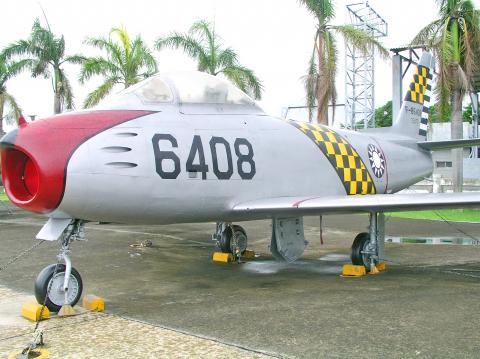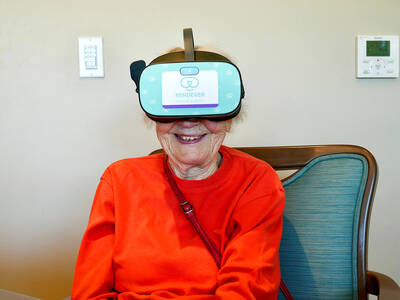Taiwan in Time: July 4 to July 10
On the morning of July 5, 1959, four F-86 Sabre fighter planes departed from the Hsinchu Air Base, their mission a simple one — to patrol the airspace over the Matsu Islands, just off the coast of China.
It was not a combat mission, but the four Taiwan-based Republic of China (ROC) Air Force pilots were still advised to be careful, as there were reports of increased enemy People’s Republic of China (PRC) MiG-17 fighter plane activity in the area.

Photo: Wang Jung-hsiang, Taipei Times
The last major battle between ROC and PRC forces concluded on Oct. 5, 1958 with the end of the Second Taiwan Strait Crisis, but minor skirmishes continued to take place.
Most incidents were not meant to be combat missions -- the planes usually set out from Taiwan to either patrol the strait or take reconnaissance photos, but there was always the risk of running into the enemy.
Because of the success of the US-provided Sabres, the aircraft was nicknamed “MiG Buster” (米格剋星). The real advantage, however, was most likely their infrared-guided Sidewinder missiles, first used in a September 1958 skirmish that led to the destruction of 10 MiGs.
This is the story as told in Wang Li-chen’s (王立楨) book, Pilot Stories (飛行員的故事). The pilots noticed the presence of four enemy planes as they flew over Wuchiu Island (烏坵). They immediately prepared for combat, and after some maneuvering Captain Chang Yen-ming (張燄明) opened fire and shot down one of the MiGs.
As the remaining MiGs split up into two groups, so did the Sabres, who continued pursuit. At this time, another group of MiGs arrived, forcing Chang Kang-ling’s (張崗陵) group to give up the chase and go on the defensive. Wang writes that Chang made a 7.5G turn and plunged straight downward toward one of the planes and opened fire, shooting it down.
Meanwhile, Chang Yen-ming’s team also ran into additional enemy planes. Chang engaged in scissor maneuvering with an enemy plane, only to find two more heading his way. To get away, he flew at full speed toward the ocean — pulling up at the last minute. One of the enemy planes did not pull up in time and crashed.
Chang Yen-ming’s groupmate, Kuan Yong-hua (關永華) also engaged in battle on his own, finally downing a fourth enemy plane. Wang writes that as the enemy pilot parachuted out of his plane, Kuan slowed down, made a circle around the pilot and saluted him before flying off.
Reports seem to vary on this event — some say that five MiGs were downed, some say that the planes set out from Chiayi, and some say that one MiG was shot down by anti-aircraft artillery on one of the ROC-controlled islands.
Aerial battles after this incident were sparse, the next recorded one being when two ROC fighters shot down a MiG in February 1960.
Lee Chiun-rong (李俊融) and Lee Ching-yi (李靜宜) write in the study, Comparing the Development and Battle Results of the Nationalist and Communist Air Forces (國共空軍發展及戰果差異之比較) that PRC was going through the disastrous Great Leap Forward and the Great Famine during that time and had little energy to devote to coastal air patrols.
The final battle, and also the final direct military engagement of any kind between the two sides took place on Jan. 13, 1967.
By that time, Taiwan had upgraded to the F-104 Starfighter and China the MiG-19, and this was reportedly the first time the first and last time an ROC Starfighter would shoot down a MiG.
This was another reconnaissance mission, and on the way back, the Starfighters were attacked by a group of MiG-19s. They shot down two enemy planes before heading back to Taiwan — but Major Yang Ching-tsung (楊敬宗) somehow disappeared on the way home.
There are many theories about what happened (which we will not delve into), and until today, Yang’s fate is still a mystery.
Taiwan in Time, a column about Taiwan’s history that is published every Sunday, spotlights important or interesting events around the nation that have anniversaries this week.

The Directorate-General of Budget, Accounting and Statistics (DGBAS) told legislators last week that because the Chinese Nationalist Party (KMT) and Taiwan People’s Party (TPP) are continuing to block next year’s budget from passing, the nation could lose 1.5 percent of its GDP growth next year. According to the DGBAS report, officials presented to the legislature, the 2026 budget proposal includes NT$299.2 billion in funding for new projects and funding increases for various government functions. This funding only becomes available when the legislature approves it. The DGBAS estimates that every NT$10 billion in government money not spent shaves 0.05 percent off

Dec. 29 to Jan. 4 Like the Taoist Baode Temple (保德宮) featured in last week’s column, there’s little at first glance to suggest that Taipei’s Independence Presbyterian Church in Xinbeitou (自立長老會新北投教會) has Indigenous roots. One hint is a small sign on the facade reading “Ketagalan Presbyterian Mission Association” — Ketagalan being an collective term for the Pingpu (plains Indigenous) groups who once inhabited much of northern Taiwan. Inside, a display on the back wall introduces the congregation’s founder Pan Shui-tu (潘水土), a member of the Pingpu settlement of Kipatauw, and provides information about the Ketagalan and their early involvement with Christianity. Most

The People’s Republic of China (PRC) was out in force in the Taiwan Strait this week, threatening Taiwan with live-fire exercises, aircraft incursions and tedious claims to ownership. The reaction to the PRC’s blockade and decapitation strike exercises offer numerous lessons, if only we are willing to be taught. Reading the commentary on PRC behavior is like reading Bible interpretation across a range of Christian denominations: the text is recast to mean what the interpreter wants it to mean. Many PRC believers contended that the drills, obviously scheduled in advance, were aimed at the recent arms offer to Taiwan by the

Like many retirement communities, The Terraces serves as a tranquil refuge for a nucleus of older people who no longer can travel to faraway places or engage in bold adventures. But they can still be thrust back to their days of wanderlust and thrill-seeking whenever caretakers at the community in Los Gatos, California, schedule a date for residents — many of whom are in their 80s and 90s — to take turns donning virtual reality headsets. Within a matter of minutes, the headsets can transport them to Europe, immerse them in the ocean depths or send them soaring on breathtaking hang-gliding expeditions